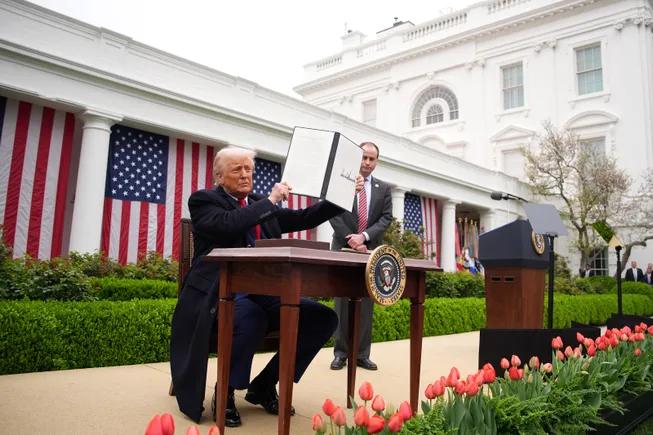Owners and developers of commercial construction projects may hesitate to move forward with new work after President Donald Trump levied fresh tariffs on more than 180 countries, according to industry sources.
On Wednesday, Trump announced a 10% baseline tariff for all U.S. trading partners with additional reciprocal tariffs for select nations, such as another 34% on Chinese imports and 20% on European Union imports.
Many key construction materials, such as steel, aluminum, lumber and copper, will be exempted from these reciprocal tariffs, according to a White House release. But importers of steel and aluminum have been paying 25% tariffs on these materials since March 12, while Canadian softwood lumber importers pay a 14.5% anti-dumping and anti-subsidy tariff, according to the National Association of Home Builders. That has been putting upward pressure on costs, said Anirban Basu, chief economist at Associated Builders and Contractors.
“Material prices are likely to rise in the coming months,” said Basu. “On the nonresidential side, keep an eye on prices for iron and steel products, as well as aluminum. Notably, domestic steel prices have already risen significantly.”

Anirban Basu
Permission granted by ABC
Price increases are expected, but they will take time to be worked into the system. Contractors tend to source products like concrete, gypsum and other raw materials domestically, so those are less likely to be impacted, said Tim Jed, supply chain leader at DPR Construction.
“However, even if products are domestically produced, tariffs could affect domestic pricing or lead times,” said Jed. “Ultimately, what matters is, where are we buying from and where are those materials being imported from, but that’s not an easy piece of information to get to.”
Future spending at risk
Nonresidential materials prices jumped at a 9% annualized rate through the first two months of 2025 as builders rushed to gather materials. Overall construction inputs now sit 41% higher than February 2020, according to ABC.
That jump in costs mixed with uncertainty on how markets will react to the new trade policy will likely start to slow construction investment activity, said Jeannine Cataldi, associate director of global construction at S&P Global Market Intelligence. That will have an impact on nonresidential construction, specifically privately funded projects.
“Most construction activity will show these effects in a lagged fashion, as projects already started will largely continue,” said Cataldi. “It is future spending that is most at risk.”
Nonresidential construction spending hit $1.26 trillion in February, the highest level on record, according to an ABC analysis of U.S. Census Bureau data released Tuesday. However, public construction projects largely accounted for that momentum, and even that may begin to fade, said Cataldi.
“Infrastructure will be impacted if funding is recalled — this is on hold currently — if rising material prices affect budgets, and the labor force is constrained by immigration policies,” said Cataldi.
Labor issues
Along with prices, economists are keeping an eye on the hiring rate. If reciprocal tariffs contribute to construction layoffs and if businesses are not expanding their staffing levels, it will be difficult for the economy to maintain growth, said Basu.
So even though contractors have escaped additional tariffs on steel, aluminum and copper, labor issues brought on by Trump’s policies could put a dent in activity, said Michael Guckes, chief economist at Cincinnati-based ConstructConnect.
“We remain very concerned about the construction labor market,” said Guckes. “With the very real possibility of a contraction in labor due to heightened unauthorized worker deportations, we could see the biggest cost concern for the industry in 2025 come not from materials but from labor.”
How the market moves following what Trump calls his Liberation Day tariffs should provide a strong indication of how businesses will approach the new trade environment, said Basu.
For data center and manufacturing contractors, for instance, activity will remain elevated regardless of tariff rates, said Basu. Construction firms can also expect substantial additional spending on highway and rail projects, and possibly broadband internet buildout in poorly connected areas, said Ken Simonson, chief economist at the Associated General Contractors of America.
Still, tariffs pose multiple threats to overall construction activity, including these sectors with strong momentum, said Simonson. Basu added prices for copper, a key material in data center construction, have jumped significantly to start 2025.
“Copper prices have taken off recently, they’ve exploded to the upside,” Basu said during an ABC economic outlook webinar on April 2. “Data centers use a ton of copper. There are some issues emerging because of these tariffs.”
Cancellations ahead?
The Trump administration is using tariffs as a tool to level the playing field with key trading partners, said Basu. He says while economists often view tariffs as bad news, a strategic move to push other countries to lower their own trade barriers could be beneficial — if it works.
“This might be a mechanism by which to really lower tariffs against U.S. exports,” said Basu. “If that’s the end game here, to use these reciprocal tariffs to do that, to chisel away and hammer away at tariffs against our exports, as an economist, I of course love that.”

Ken Simonson
Courtesy of AGC
Trump said on Wednesday that companies can avoid tariffs by making their products in the U.S. Although there may be some examples of firms opening or expanding manufacturing facilities in the U.S. as a result of tariffs, these are likely to be outweighed by the value of projects that are canceled, said Simonson.
Tariffs are costly for contractors that have committed to a project at a fixed or guaranteed maximum price contract and have not locked in the price of materials. If contractors raise prices to account for tariffs, some owners may cancel, defer or scale back upcoming projects, said Simonson.
“But the biggest threat is from producers and logistics firms that face higher costs or lose export sales as foreign governments and consumers raise tariffs and nontariff barriers or boycott U.S. products,” said Simonson. “These companies and their workers will reduce spending, including for construction.”
The suddenness of the implementation, with the tariffs going into effect immediately, could cause whiplash for certain economic actors, said Basu. He said there’s usually a buffer between when a policy is announced and when it takes effect.
“Think long and hard about cashflow, and do not hold on to unnecessary cost centers for too long,” said Basu. “Put another way, contractors should focus on retaining cash.”
Jed added there is no one-size-fits-all approach. Simply buying products and materials now to lock in the best price may not be the right strategy.
“We let our teams work with the tools that we’ve built internally to look strategically on a project-by-project basis of what makes the most sense,” said Jed. “Don’t overreact.”

